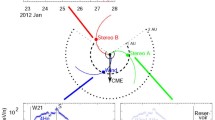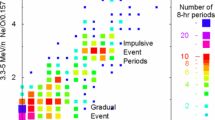Abstract
We have spent 50 years in heated discussion over which populations of solar energetic particles (SEPs) are accelerated at flares and which by shock waves driven out from the Sun by coronal mass ejections (CMEs). The association of the large “gradual” SEP events with shock acceleration is supported by the extensive spatial distribution of SEPs and by the delayed acceleration of the particles. Recent STEREO observations have begun to show that the particle onset times correspond to the observed time of arrival of the shock on the observer’s magnetic flux tube and that the SEP intensities are related to the local shock speed. The relative abundances of the elements in these gradual events are a measure of those in the ambient solar corona, differing from those in the photosphere by a widely-observed function of the first ionization potential (FIP) of the elements. SEP events we call “impulsive”, the traditional “3He-rich” events with enhanced heavy-element abundances, are associated with type III radio bursts, flares, and narrow CMEs; they selectively populate flux tubes that thread a localized source, and they are fit to new particle-in-cell models of magnetic reconnection on open field lines as found in solar jets. These models help explain the strong enhancements seen in heavy elements as a power (of 2–8) in the mass-to-charge ratio \(A/Q\) throughout the periodic table from He to Pb. A study of the temperature dependence of \(A/Q\) shows that the source plasma in impulsive SEP events must lie in the range of 2–4 MK to explain the pattern of abundances. This is much lower than the temperatures of >10 MK seen on closed loops in solar flares. Recent studies of \(A/Q\)-dependent enhancements or suppressions from scattering during transport show source plasma temperatures in gradual SEP events to be 0.8–1.6 MK in 69 % of the events, i.e. coronal plasma; 24 % of the events show reaccelerated impulsive-event material.






















Similar content being viewed by others
References
V. Archontis, A.W. Hood, Astrophys. J. Lett. 769, L21 (2013)
M. Arnaud, J. Raymond, Astrophys. J. 398, 394 (1992)
M. Arnaud, R. Rothenflug, Astron. Astrophys. Suppl. Ser. 60, 425 (1985)
M. Asplund, N. Grevesse, A.J. Sauval, P. Scott, Annu. Rev. Astron. Astrophys. 47, 481 (2009)
E. Caffau, H.-G. Ludwig, M. Steffen, B. Freytag, P. Bonofacio, Sol. Phys. 268, 255 (2011). doi:10.1007/s11207-010-9541-4
H.V. Cane, S.W. Kahler, N.R. Sheeley Jr., J. Geophys. Res. 91, 13321 (1986)
H.V. Cane, D.V. Reames, T.T. von Rosenvinge, J. Geophys. Res. 93, 9555 (1988)
E.E. Chollet, J. Giacalone, Astrophys. J. 688, 64 (2011)
E.W. Cliver, Astrophys. J. 639, 1206 (2006)
E.W. Cliver, A.G. Ling, Astrophys. J. 658, 1349 (2007)
E.W. Cliver, A.G. Ling, Astrophys. J. 690, 598 (2009)
M.A. Coplan, K.W. Ogilvie, P. Bochsler, J. Geiss, Sol. Phys. 93, 415 (1985)
M.I. Desai, G.M. Mason, J.R. Dwyer, J.E. Mazur, R.E. Gold, S.M. Krimigis, C.W. Smith, R.M. Skoug, Astrophys. J. 588, 1149 (2003)
M.I. Desai, G.M. Mason, M.E. Wiedenbeck, C.M.S. Cohen, J.E. Mazur, J.R. Dwyer, R.E. Gold, S.M. Krimigis, Q. Hu, C.W. Smith, R.M. Skoug, Astrophys. J. 661, 1156 (2004)
M.I. Desai, G.M. Mason, R.E. Gold, S.M. Krimigis, C.M.S. Cohen, R.A. Mewaldt, J.E. Mazur, J.R. Dwyer, Astrophys. J. 649, 740 (2006)
R. DiFabio, Z. Guo, E. Möbius, B. Klecker, H. Kucharek, G.M. Mason, M. Popecki, Astrophys. J. 687, 623 (2008)
J.F. Drake, M. Swizdak, Phys. Plasmas 21, 27903 (2014)
J.F. Drake, P.A. Cassak, M.A. Shay, M. Swisdak, E. Quataert, Astrophys. J. Lett. 700, L16 (2009)
J.F. Drake, M. Opher, M. Swizdak, J.N. Chamoun, Astrophys. J. 709, 963 (2010)
D. Ellison, R. Ramaty, Astrophys. J. 298, 400 (1985)
J. Giacalone, Astrophys. J. 624, 765 (2005)
N. Gopalswamy, S. Yashiro, G. Michalek, M.L. Kaiser, R.A. Howard, D.V. Reames, R. Leske, T. von Rosenvinge, Astrophys. J. Lett. 572, L103 (2002)
N. Gopalswamy, S. Yashiro, S. Krucker, G. Stenborg, R.A. Howard, J. Geophys. Res. 109, A12105 (2004)
N. Gopalswamy, H. Xie, S. Yashiro, S. Akiyama, P. Mälekä, I.G. Usoskin, Space Sci. Rev. 171, 23 (2012). doi:10.1007/s11214-012-9890-4
N. Gopalswamy, H. Xie, S. Akiyama, S. Yashiro, I.G. Usoskin, J.M. Davila, Astrophys. J. Lett. 765, L30 (2013)
N. Gopalswamy, P. Mäkelä, S. Akiyama, S. Yashiro, H. Xie, N. Thakur, S.W. Kahler, Astrophys. J. 806, 8 (2015)
J.T. Gosling, J. Geophys. Res. 98, 18937 (1993)
J.T. Gosling, J.R. Asbridge, S.J. Bame, W.C. Feldman, R.D. Zwickl, G. Paschmann, N. Sckopke, R.J. Hynds, J. Geophys. Res. 86, 547 (1981)
K.C. Hsieh, J.A. Simpson, Astrophys. J. Lett. 162, L191 (1970)
H.S. Hudson, Eos Trans. AGU 76(41), 405 (1995)
H.S. Hudson, B. Haisch, K.T. Strong, J. Geophys. Res. 100, 3473 (1995)
F.C. Jones, D.E. Ellison, Space Sci. Rev. 58, 259 (1991)
S.W. Kahler, J. Geophys. Res. 87, 3439 (1982)
S.W. Kahler, Astrophys. J. 428, 837 (1994)
S.W. Kahler, J. Geophys. Res. 106, 20947 (2001)
S.W. Kahler, N.R. Sheeley Jr., R.A. Howard, M.J. Koomen, D.J. Michels, R.E. McGuire, T.T. von Rosenvinge, D.V. Reames, J. Geophys. Res. 89, 9683 (1984)
S.W. Kahler, E.W. Cliver, H.V. Cane, R.E. McGuire, R.G. Stone, N.R. Sheeley Jr., Astrophys. J. 302, 504 (1986)
S.W. Kahler, A.H. McAllister, H.V. Cane, Astrophys. J. 533, 1063 (2000)
S.W. Kahler, D.V. Reames, N.R. Sheeley Jr., Astrophys. J. 562, 558 (2001)
S.W. Kahler, D.V. Reames, E.W. Cliver, in 34th Intl. Cosmic Ray Conf. (2015). arXiv:1509.09260 (in press)
B. Klecker, E. Möbius, M.A. Popecki, M.A. Lee, A.T. Bogdanov, in Solar and Galactic Composition, vol. CP-598, ed. by R.F. Wimmer-Schweingruber (AIP, Melville, 2001), p. 317
K. Knizhnik, M. Swisdak, J.F. Drake, Astrophys. J. Lett. 743, L35 (2011)
J.M. Laming, Astrophys. J. 614, 1063 (2004)
J.M. Laming, Astrophys. J. 695, 954 (2009)
D. Lario, A. Aran, R. Gómez-Herrero, N. Dresing, B. Heber, G.C. Ho, R.B. Decker, E.C. Roelof, Astrophys. J. 767, 41 (2013)
M.A. Lee, J. Geophys. Res. 88, 6109 (1983)
M.A. Lee, Astrophys. J. Suppl. Ser. 158, 38 (2005)
M.A. Lee, R.A. Mewaldt, J. Giacalone, Space Sci. Rev. 173, 247 (2012)
G. Li, R. Moore, R.A. Mewaldt, L. Zhao, A.W. Labrador, Space Sci. Rev. 171, 141 (2012)
S. Liu, V. Petrosian, G.M. Mason, Astrophys. J. 636, 462 (2006)
J.L. Lovell, M.L. Duldig, J.E. Humble, J. Geophys. Res. 103, 23733 (1998)
N. Mandzhavidze, R. Ramaty, B. Kozlovsky, Astrophys. J. 518, 918 (1999)
G.M. Mason, Space Sci. Rev. 130, 231 (2007)
G.M. Mason, G. Gloeckler, D. Hovestadt, Astrophys. J. 280, 902 (1984)
G.M. Mason, D.V. Reames, B. Klecker, D. Hovestadt, T.T. von Rosenvinge, Astrophys. J. 303, 849 (1986)
G.M. Mason, J.E. Mazur, J.R. Dwyer, Astrophys. J. Lett. 525, L133 (1999)
G.M. Mason, J.E. Mazur, J.R. Dwyer, J.R. Jokipii, R.E. Gold, S.M. Krimigis, Astrophys. J. 606, 555 (2004)
G.M. Mason, M.I. Desai, C.M.S. Cohen, R.A. Mewaldt, E.C. Stone, J.R. Dwyer, Astrophys. J. Lett. 647, L65 (2006)
J.E. Mazur, G.M. Mason, J.R. Dwyer, J. Giacalone, J.R. Jokipii, E.C. Stone, Astrophys. J. 532, L79 (2000)
P. Mazzotta, G. Mazzitelli, S. Colafrancesco, N. Vittorio, Astron. Astrophys. Suppl. Ser. 133, 403 (1998)
R.A. Mewaldt, M.D. Looper, C.M.S. Cohen, D.K. Haggerty, A.W. Labrador, R.A. Leske, G.M. Mason, J.E. Mazur, T.T. von Rosenvinge, Space Sci. Rev. 171, 97 (2012)
J.P. Meyer, Astrophys. J. Suppl. Ser. 57, 151 (1985)
J.A. Miller, Eos Trans. AGU 76(41), 401 (1995)
J.A. Miller, P.J. Cargill, A.G. Emslie, G.D. Holman, B.R. Dennis, T.H. LaRosa, R.M. Winglee, S.G. Benka, S. Tsuneta, J. Geophys. Res. 102, 14631 (1997)
R.L. Moore, J.W. Cirtain, A.C. Sterling, D.A. Falconer, Astrophys. J. 720, 757 (2010)
R.J. Murphy, R. Ramaty, B. Kozlovsky, D.V. Reames, Astrophys. J. 371, 793 (1991)
G. Newkirk Jr., D.G. Wenzel, J. Geophys. Res. 83, 2009 (1978)
C.K. Ng, D.V. Reames, Astrophys. J. Lett. 686, L123 (2008)
C.K. Ng, D.V. Reames, A.J. Tylka, Astrophys. J. 591, 461 (2003)
C.K. Ng, D.V. Reames, A.J. Tylka, in Physics of the Heliosphere: A 10 Year Retrospective, ed. by J. Heerikhuisen, G. Li, N.V. Pogorelov. AIP, vol. CP-1436 (2012), p. 212. doi:10.1063/1.4723610
D.E. Post, R.V. Jensen, C.B. Tarter, W.H. Grasberger, W.A. Lokke, At. Data Nucl. Data Tables 20, 397 (1977)
D.V. Reames, Astrophys. J. Lett. 358, L63 (1990)
D.V. Reames, Adv. Space Res. 15(7), 41 (1995a)
D.V. Reames, Eos Trans. AGU 76(41), 401 (1995b)
D.V. Reames, Rev. Geophys. 33, 585 (1995c)
D.V. Reames, Space Sci. Rev. 85, 327 (1998)
D.V. Reames, Space Sci. Rev. 90, 413 (1999)
D.V. Reames, Astrophys. J. Lett. 540, L111 (2000)
D.V. Reames, Astrophys. J. Lett. 571, L63 (2002)
D.V. Reames, Astrophys. J. 693, 812 (2009a)
D.V. Reames, Astrophys. J. 706, 844 (2009b)
D.V. Reames, Space Sci. Rev. 175, 53 (2013)
D.V. Reames, Sol. Phys. 289, 977 (2014). doi:10.1007/s11207-013-0350-4
D.V. Reames, Solar Phys. (2015). arXiv:1509.08948, submitted for publication
D.V. Reames, C.K. Ng, Astrophys. J. 610, 510 (2004)
D.V. Reames, C.K. Ng, Astrophys. J. 722, 1286 (2010)
D.V. Reames, R.G. Stone, Astrophys. J. 308, 902 (1986)
D.V. Reames, T.T. von Rosenvinge, R.P. Lin, Astrophys. J. 292, 716 (1985)
D.V. Reames, T.T. von Rosenvinge, R. Ramaty, G.M. Mason, D.C. Hamilton, M.A. Forman, W.R. Webber, in Particle Astrophysics—The NASA Program for the 1990s and Beyond, GSFC 1989, vol. CP-203, ed. by W.V. Jones, F.J. Kerr, J.F. Ormes (AIP, New York, 1990), p. 32
D.V. Reames, J.P. Meyer, T.T. von Rosenvinge, Astrophys. J. Suppl. Ser. 90, 649 (1994)
D.V. Reames, S.W. Kahler, C.K. Ng, Astrophys. J. 491, 414 (1997)
D.V. Reames, C.K. Ng, A.J. Tylka, Astrophys. J. Lett. 531, L83 (2000)
D.V. Reames, E.W. Cliver, S.W. Kahler, Sol. Phys. 289, 3817 (2014a). arXiv:1404.3322. doi:10.1007/s11207-014-0547-1
D.V. Reames, E.W. Cliver, S.W. Kahler, Sol. Phys. 289, 4675 (2014b). arXiv:1407.7838. doi:10.1007/s11207-014-0589-4
D.V. Reames, E.W. Cliver, S.W. Kahler, Sol. Phys. 290, 1761 (2015). arXiv:1505.02741. doi:10.1007/s11207-015-0711-2
G.C. Reid, J. Geophys. Res. 69, 2659 (1964)
I. Roth, M. Temerin, Astrophys. J. 477, 940 (1997)
A.C. Rouillard, D. Odstrčil, N.R. Sheeley Jr., A.J. Tylka, A. Vourlidas, G. Mason, C.-C. Wu, N.P. Savani, B.E. Wood, C.K. Ng et al., Astrophys. J. 735, 7 (2011)
A. Rouillard, N.R. Sheeley Jr., A. Tylka, A. Vourlidas, C.K. Ng, C. Rakowski, C.M.S. Cohen, R.A. Mewaldt, G.M. Mason, D. Reames et al., Astrophys. J. 752, 44 (2012)
A. Sandroos, R. Vainio, Astron. Astrophys. 507, L21 (2009)
J.T. Schmelz, D.V. Reames, R. von Steiger, S. Basu, Astrophys. J. 755, 33 (2012)
M. Shimojo, K. Shibata, Astrophys. J. 542, 1100 (2000)
Z. Svestka, Sol. Phys. 160, 53 (1995)
M. Temerin, I. Roth, Astrophys. J. Lett. 391, L105 (1992)
L.C. Tan, D.V. Reames, C.K. Ng, X. Shao, L. Wang, Astrophys. J. 728, 133 (2011)
L.C. Tan, O.E. Malandraki, D.V. Reames, C.K. Ng, L. Wang, I. Patsou, A. Papaioannou, Astrophys. J. 768, 68 (2013)
J.K. Thalmann, Y. Su, M. Temmer, A.M. Veronig, Astrophys. J. Lett. 801, L23 (2014)
A.J. Tylka, C.M.S. Cohen, W.F. Dietrich, S. Krucker, R.E. McGuire, R.A. Mewaldt, C.K. Ng, D.V. Reames, G.H. Share, in Proc. 28th Int. Cosmic Ray Conf. (2003), p. 3305
A.J. Tylka, C.M.S. Cohen, W.F. Dietrich, M.A. Lee, C.G. Maclennan, R.A. Mewaldt, C.K. Ng, D.V. Reames, Astrophys. J. 625, 474 (2005)
A.J. Tylka, M.A. Lee, Astrophys. J. 646, 1319 (2006)
A.J. Tylka, O.E. Malandraki, G. Dorrian, Y.-K. Ko, R.G. Marsden, C.K. Ng, C. Tranquille, Solar Phys. 172 (2012). doi:10.1007/s11207-012-0064-z
J.P. Wild, S.F. Smerd, A.A. Weiss, Annu. Rev. Astron. Astrophys. 1, 291 (1963)
G.P. Zank, W.K.M. Rice, C.C. Wu, J. Geophys. Res. 105, 25079 (2000)
Acknowledgements
This paper was originally presented as an invited plenary talk at the Solar Heliospheric and Interplanetary Environment (SHINE, http://shinecon.org/) conference in Stowe, VT on July 6, 2015. The author thanks Georgia de Nolfo and the conference organizing committee for their support. The author also thanks Steve Kahler for comments on the manuscript and Lun Tan for helpful discussions.
Author information
Authors and Affiliations
Corresponding author
Rights and permissions
About this article
Cite this article
Reames, D.V. What Are the Sources of Solar Energetic Particles? Element Abundances and Source Plasma Temperatures. Space Sci Rev 194, 303–327 (2015). https://doi.org/10.1007/s11214-015-0210-7
Received:
Accepted:
Published:
Issue Date:
DOI: https://doi.org/10.1007/s11214-015-0210-7




